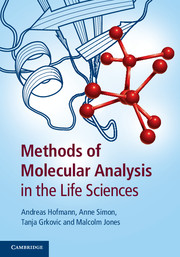3 - Structural methods
Published online by Cambridge University Press: 05 July 2014
Summary
Electron paramagnetic resonance
Prior to any detailed discussion of electron paramagnetic resonance (EPR) and nuclear magnetic resonance (NMR) methods, it is worthwhile considering the more general phenomena applicable to both.
Magnetic phenomena
Magnetism arises from the motion of charged particles, and, for the purpose of this discussion, the major contribution to magnetism in molecules is due to the spin of the charged particle.
In chemical bonds of a molecule, the negatively charged electrons have a spin controlled by strict quantum rules. A bond is constituted by two electrons with opposite spins occupying the appropriate molecular orbital. According to the Pauli principle, the two electrons must have opposite spins, leading to the term ‘paired electrons’. Each of the spinning electronic charges generates a magnetic effect, but in electron pairs this effect is almost self-cancelling. In atoms, a value for magnetic susceptibility may be calculated and is of the order of −10−6 g−1. This diamagnetism is a property of all substances, because they all contain the miniscule magnets, i.e. electrons. Diamagnetism is temperature independent.
If an electron is unpaired, there is no counterbalancing opposing spin and the magnetic susceptibility is of the order of +10−3 to +10−4 g−1. The effect of an unpaired electron exceeds the ‘background’ diamagnetism and gives rise to paramagnetism. The most notable example is certainly the paramagnetism of metals such as iron, cobalt and nickel, which are the materials that permanent magnets are made of. The paramagnetism of these metals is called ferromagnetism. In biochemical investigations, systems with free electrons (radicals) are frequently used as probes.
- Type
- Chapter
- Information
- Methods of Molecular Analysis in the Life Sciences , pp. 95 - 147Publisher: Cambridge University PressPrint publication year: 2014



